San Marzano tomatoes are highly prized for their sweet, rich flavor, meaty texture, and low acidity. These plum tomatoes are native to Italy and are perfect for making sauces, canning, and cooking. This article will explore how to grow San Marzano tomatoes from seeds and help you cultivate a bountiful harvest.
1. Introduction to San Marzano Tomatoes
Italy San Marzano Tomatoes: History and Characteristics
San Marzano tomatoes originated in the small town of San Marzano sul Sarno near Mount Vesuvius in Italy. The volcanic soil in this region lends a unique flavor and mineral composition to these tomatoes. San Marzano varieties are heirloom tomatoes, meaning they have been passed down through generations and remain true to their original characteristics.
Best San Marzano Tomato Seeds For Sale

$2.49
Grow Authentic Heirloom San Marzano Tomatoes – Easy to Grow Non-GMO Seeds Our San Marzano Tomato Seeds are the perfect choice for any home gardener looking to grow authentic, high-quality tomatoes. These heirloom, non-GMO, non-hybrid, open-pollinated seeds produce the renowned San… read more
Differences Between San Marzano and Roma Tomatoes
While both San Marzano and Roma tomatoes are considered plum tomatoes, they have distinct differences:
- San Marzano tomatoes are longer and thinner, with thicker flesh and fewer seeds.
- San Marzano tomatoes have a sweeter, richer flavor, making them ideal for sauces and canning.
- Roma tomatoes have a higher yield but are less flavorful than San Marzano tomatoes.
2. Starting San Marzano Tomato Seeds Indoors
When to Start San Marzano Tomato Seeds
Begin your San Marzano tomato seeds indoors 6-8 weeks before your last frost date. This will give the seedlings ample time to grow strong before transplanting them outdoors.
Supplies Needed for Starting San Marzano Tomato Seeds
To start your San Marzano tomato seeds, you'll need the following:
- San Marzano tomato seeds
- Seedling trays or small pots
- Seed starting mix
- Heating mat (highly recommended)
- Grow lights (highly recommended)
Tomato Seed Assortment | 8 Variety Pack

$15.95
8 Tomato Seeds Variety Pack – Heirloom, Non-Hybrid, Open-Pollinated, Non-GMO – Perfect for Home Gardens! Unlock the secrets to a thriving tomato garden with our premium 8 Tomato Seeds Variety Pack! Carefully curated for tomato lovers and gardening enthusiasts alike, this… read more
Steps for Starting San Marzano Tomato Seeds
- Fill your seedling trays or pots with seed starting mix.
- Place 1-2 San Marzano tomato seeds in each cell or pot, pushing them about ¼ inch deep into the soil.
- Lightly cover the seeds with soil and water gently to moisten them.
- Place the trays or pots on a heating mat to maintain a consistent soil temperature of 70-80°F.
- Keep the soil consistently moist but not waterlogged.
- Seedlings should emerge in 7-14 days. Once germinating, move them to a sunny windowsill or place them under grow lights for 14-16 hours daily.
3. Transplanting San Marzano Tomato Seedlings
Preparing Seedlings for Transplanting
Before transplanting your San Marzano tomato seedlings, you must "harden them off." This process helps seedlings gradually acclimate to outdoor conditions. Begin hardening off about 1-2 weeks before your last frost date:
- Place seedlings outdoors in a sheltered location with filtered sunlight for a few hours daily.
- Gradually increase their time outdoors and exposure to the full sun over a week.
Selecting the Perfect Location for Your San Marzano Tomato Plant
Choose a location in your garden that receives full sun (at least 6-8 hours per day) and has well-draining soil. San Marzano tomatoes thrive in temperatures between 70-85°F.
Steps for Transplanting San Marzano Tomato Seedlings
- Prepare your planting area by amending the soil with compost and a slow-release fertilizer.
- Dig a hole for each seedling, spacing them about 24-36 inches apart.
- Carefully remove the seedling from its container and place it in the hole, burying it more deeply than in the pot. This encourages more roots to form along the buried stem, resulting in a more vigorous plant.
- Fill the hole with soil, firming it around the base of the plant.
- Water the transplanted seedlings thoroughly.
4. Supporting Your San Marzano Tomato Plant
Since San Marzano tomatoes can grow up to 6 feet tall, it's essential to provide them with proper support. Tomato cages, stakes, or trellises are all suitable options for supporting your tomato plants.
Tomato Cages
Tomato cages are a popular choice due to their ease of use. Place a cage around each tomato plant, ensuring it's firmly anchored in the ground. As the plant grows, its branches naturally lean on the cage for support.
Stakes
Staking your San Marzano tomato plant involves tying the main stem to a sturdy stake, usually 6-8 feet tall. Continue tying the plant to the stake at 12-inch intervals as it grows.
Trellises
Trellises are another option for providing support to your San Marzano tomato plants. Train the tomato vines to grow vertically along the trellis, securing them with ties as needed.
Heirloom Tomato Seeds for Planting | 16 Variety Pack

$19.95
The Ultimate Tomato Seed Variety Set - 16 Heirloom, Non-GMO Tomato Varieties for Your Home Garden Introducing our 16 Tomato Seeds Variety Pack, a must-have collection for any gardening enthusiast or professional grower! This premium seed assortment includes a diverse selection… read more
5. Watering and Fertilizing San Marzano Tomatoes
Watering
San Marzano tomatoes require consistent moisture to prevent issues like blossom end rot. Water your plants deeply and regularly, providing 1-2 inches of water per week. Avoid overhead watering, which can lead to diseases.
Fertilizing
Following the manufacturer's recommendations, feed your San Marzano tomatoes with a balanced, water-soluble fertilizer every 2-4 weeks. Be cautious not to over-fertilize, as this can cause excessive foliage growth at the expense of fruit production.
6. Pruning and Training San Marzano Tomato Plants
Pruning your San Marzano tomato plants helps to improve air circulation, reduce disease, and promote better fruit production. Focus on removing suckers and small shoots that grow between the main stem and leaf axils. Regularly pinch off suckers when they are small to prevent excessive plant growth.
7. Common Pests and Diseases Affecting San Marzano Tomatoes
Like other tomato varieties, San Marzano tomatoes can be affected by various pests and diseases. Some common issues include:
- Aphids
- Tomato hornworms
- Fusarium wilt
- Verticillium wilt
- Blossom end rot
Monitor your plants regularly and promptly address problems to maintain healthy, productive plants.
8. Harvesting Your San Marzano Tomatoes
San Marzano tomatoes typically take around 80 days from transplanting to reach maturity. Harvest your tomatoes when they are a deep red and slightly firm to the touch. To harvest, simply cut the fruit from the vine with a pair of scissors or pruners.
Conclusion
Growing San Marzano tomatoes from seed can be a rewarding experience, resulting in delicious and versatile fruits. Following the steps outlined in this guide, you'll be well on your way to cultivating a bountiful harvest of these tasty heirloom tomatoes. Enjoy the fruits of your labor in sauces, salads, and other culinary creations.

Frequently Asked Questions - How to Grow San Marzano's From Seed
Q1: Are San Marzano tomatoes determinate or indeterminate?
A1: San Marzano tomatoes are indeterminate, which means they continue to grow and produce fruit throughout the growing season until the first frost. This contrasts to determinate tomatoes, which grow to a fixed size and have all their fruit quickly.
Q2: Can I grow San Marzano tomatoes in containers?
A2: Yes, you can grow San Marzano tomatoes in containers. Choose a large container with a minimum capacity of 5 gallons and ensure it has adequate drainage holes. Fill the container with a high-quality potting mix and provide the tomato plant with proper support, such as a cage or stake.
Q3: How do I save seeds from my San Marzano tomatoes for next year?
A3: To save seeds from your San Marzano tomatoes:
- Choose fully ripe, healthy tomatoes from your best-performing plants.
- Cut the tomato in half, scoop the seeds, and place them in a jar with some water.
- Allow the mixture to ferment for a few days, stirring occasionally.
- Once the seeds have separated from the pulp, rinse them thoroughly and spread them on a paper towel or plate to dry.
- Store the dried seeds in a cool, dark place until the next planting season.
Rare Tomato Seeds | 5 Variety Pack

$9.95
Grow Unique Tomatoes: 5 Rare Tomato Seeds Collection for Your Garden Introducing our 5 Rare Tomato Seeds Variety Pack, a must-have for every tomato lover and avid gardener! This premium collection features a curated selection of rare heirloom tomato seeds to… read more
Q4: How can I prevent blossom end rot in my San Marzano tomatoes?
A4: Blossom end rot is a common issue caused by calcium deficiency and irregular watering. To prevent blossom end rot:
- Maintain consistent moisture levels by watering your plants deeply and regularly.
- Avoid over-watering or letting the soil dry out completely between waterings.
- Apply a calcium-rich fertilizer or crushed eggshells to the planting hole when transplanting.
- Use mulch to help retain moisture and regulate soil temperature.
Q5: How can I tell if my San Marzano tomatoes are ripe and ready for harvest?
A5: San Marzano tomatoes are ripe when they have reached a deep red color and are slightly firm to the touch. Avoid letting them become overly soft, affecting their flavor and texture. To harvest, simply cut the fruit from the vine with a pair of scissors or pruners.
Q6: Can I grow San Marzano tomatoes in cooler climates?
A6: While San Marzano tomatoes thrive in warmer temperatures, they can still be grown in cooler climates with extra care. Start your seeds indoors early and transplant them outdoors after the last frost date. Choose a sunny, sheltered location and use black plastic mulch or floating row covers to help warm the soil and protect your plants from chilly temperatures.







